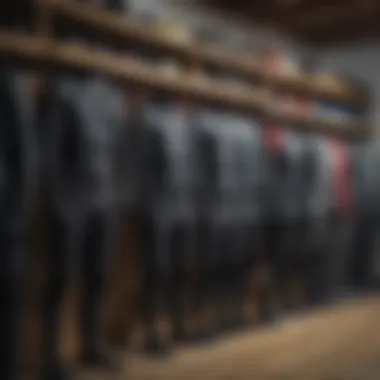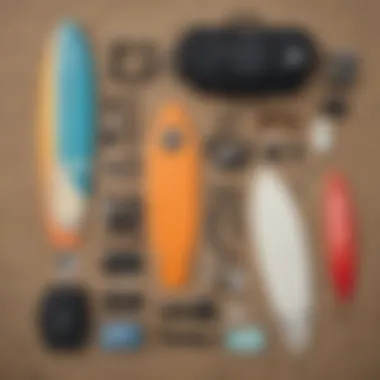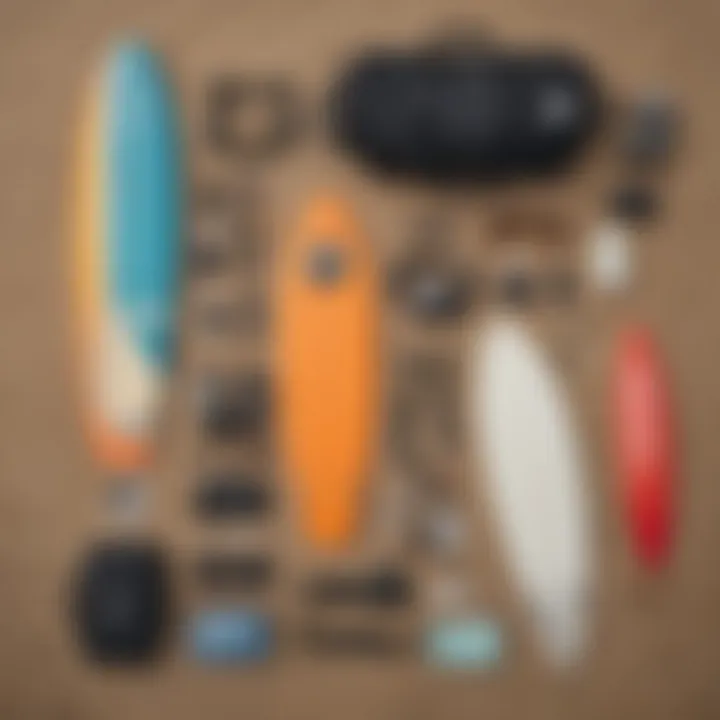Essential Surf Products for Every Surfer


Intro
Surfing is more than just a sport; it’s a lifestyle that binds communities through waves and experiences. Whether you’re a newcomer just trying to ride your first wave or a seasoned pro looking for the perfect gear, understanding the essentials of surf products can significantly enhance your performance and enjoyment in the water. The ocean is a vast playground, and having the right tools at your disposal is critical in navigating its challenges while maximizing fun.
In this guide, we’ll dissect the world of surf products, diving into the various categories that make up a surfer’s arsenal. From surfboards to wetsuits, and everything in between, we'll provide insights tailored to your needs, whether you’re paddling out solo or hitting the beach with friends. We’ll also address care and maintenance to ensure your gear remains in top-notch condition. Let’s embark on this wave of knowledge to better equip ourselves for our next adventure in the surf!
Gear Essentials
When it comes to surfing, having the right gear is half the battle won. As they say, the right equipment can turn a good surf session into a great one. Knowing what to look for in surf products can be daunting, but we’ll break it down into manageable chunks to simplify your decision-making process.
Top Picks for Watersports Equipment
Choosing the best gear involves familiarity with various types of equipment. Here are some of the essentials every surfer should consider:
- Surfboards: Debating between shortboards or longboards? Each has its merits. Shortboards are ideal for agile surfers in choppy waters, while longboards provide stability and are great for beginners. Choose what fits your style.
- Wetsuits: Depending on the water temperature, a wetsuit can be your best friend. A high-quality wetsuit traps warmth and protects your skin. Brands like O'Neill and Rip Curl offer excellent options.
- Leashes: Don’t skimp on the leash. This often overlooked piece connects you to your board and keeps it from wandering off in the surf. Make sure it’s the right size and strength.
- Surfboard Wax: Essential for grip, wax prevents slipping. Always check your board before hitting the waves to make sure it has sufficient lubrication.
Each piece of gear plays its part in a successful surf experience. A well-chosen board can make you feel like a pro, while a snug wetsuit can mean the difference between a great day and a freezing one.
Maintenance and Care Tips for Gear
Your equipment is an investment, and taking care of it is crucial to maintaining performance. Here are some tips:
- Regular Cleaning: After each surf session, rinse your board and wetsuit in fresh water to remove salt. This will prolong their lifespan.
- Storage: Store your board in a cool, shaded place. Avoid leaving it in direct sunlight for long periods—this can warp your board.
- Check for Dings: Regularly inspect your board for dings or cracks. Repairs should be made promptly to prevent further damage.
- Air Out Your Wetsuit: After use, hang your wetsuit inside out to dry. Avoid crumpling to prevent odors.
Following these simple steps can keep your gear pristine and ensure you’re always ready to ride those perfect waves.
"The best surfers aren’t those who catch the most waves, but those who understand their gear inside and out."
Next, we delve into techniques and tips that cater to every surfing level. Getting that dream wave requires more than just having the right equipment—it’s about knowing how to use it!
Stay tuned!
Understanding Surf Products
Knowing the ins and outs of surf products is as crucial as the tides for a surfer. It sets the stage for your experience in the water and plays a pivotal role in enhancing performance and safety. Whether you're a veteran riding the biggest waves or a newcomer just finding your feet, having the right gear can spell the difference between a memorable day and a frustrating one.
Importance of Quality Gear
Quality gear is not merely about looking sharp on the beach. It can significantly impact your enjoyment and safety when out on the water. Investing in high-quality surf equipment means you’re more likely to stay comfortable, agile, and even safer during your sessions. Consider the following benefits of opting for well-crafted surf products:
- Durability: Quality gear withstands the elements better, meaning less frequent replacements and ultimately lower costs over time.
- Performance: High-grade materials often lead to better performance. For example, a finely crafted surfboard can improve your maneuvers, making it easier to catch that elusive wave.
- Comfort: When you’re comfortable, you can focus on what you love. An excellent wetsuit that fits right can help you stay warm during those chilly sessions.
In short, quality gear is like having a solid foundation for a house. Without it, everything else is at risk.
Types of Surf Products Available
The surf gear market is a treasure trove of diverse options, catering to a wide range of surfing styles and preferences. Here’s a snapshot of the core types of surf products you’ll encounter:
- Surfboards: The very heart of the surfing experience, with types ranging from shortboards, longboards, fish boards, to gun boards, each suited for different surfing styles and conditions.
- Wetsuits: Essential for comfort and warmth, wetsuits come in various configurations, from full suits providing maximum coverage to shorty suits perfect for warmer waters.
- Surf Accessories: These include leashes, fins, and board bags. While often overlooked, they play a critical role in enhancing your performance and ensuring your board's safety.
- Safety Gear: Helmets, impact vests, and other safety products that help minimize risk, especially for those surfing in challenging conditions.
Understanding these products helps surfers align their gear with their goals, ensuring their time in the water is productive, enjoyable, and safe.
Surf Boards
When it comes to surfing, the surf board serves as the very foundation upon which all the excitement unfolds. It’s more than just a piece of equipment; it becomes an extension of a surfer, a bridge to ride the exhilarating waves and connect with the ocean. Choosing the right surfboard can significantly impact performance, comfort, and safety on the water. With the variety of surfboards available, understanding their unique characteristics and intended uses is crucial, making this section an integral part of your surfing experience.
Different Types of Surfboards
Shortboards
Shortboards are often considered the go-to option for surfers seeking performance in quicker, more aggressive maneuvers. These boards typically measure between 5 to 7 feet in length and have a pointed nose, enabling sharper turns and faster speeds. Their design caters mostly to advanced surfers who relish the challenge of tackling bigger waves and complex ocean conditions.
One of the standout traits of shortboards is their ability to slice through the water with precision. The shorter length allows for rapid response and heightened agility. However, a significant disadvantage is that they can be tricky for beginners, especially in terms of balance and paddling. For those willing to put in the time and practice, a shortboard can ultimately lead to a rewarding ride.
Longboards
On the other end of the spectrum, longboards provide a more stable and forgiving experience, typically measuring between 8 to 12 feet. Their broader design lends itself to easier paddling and catching smaller waves, making them an ideal choice for novice surfers or those who simply want to enjoy a leisurely day on the water.
Longboards are often celebrated for their classic style and smooth rides. The unique feature here is the nose ride capability; a longboard can allow surfers to hang ten, giving that satisfying feeling of balance and grace. However, their size can present challenges in maneuverability, especially in crowded surf conditions.
Fish Boards
Fusing aspects from both shortboards and longboards, fish boards present an interesting alternative. These boards are typically shorter and wider than traditional shortboards, averaging about 5 to 6.5 feet in length. This distinctive shape allows for increased floatation and stability, making them suitable for a wide range of abilities.


The fish board’s character lies in its unique twin fin or thruster setup, granting agile turning capabilities and the ability to perform smooth cuts. This board is particularly popular among surfers who enjoy carving through smaller, mushier waves, but it might not deliver the same speed as a conventional shortboard on steep, powerful waves.
Gun Boards
Gun boards are specifically tailored for surfers intent on tackling larger waves, often exceeding 8 feet in length. Their pointed nose and streamlined shape help cut through the water effectively. These boards are designed for experienced surfers who crave the adrenaline rush of surfing massive swells, such as those found in notorious surf spots.
A significant advantage of gun boards is their ability to provide the stability needed when riding heightened waves. Expelling water efficiently, they help maintain speed during challenging conditions. However, their size can make paddling back out after a wipeout a real test of endurance.
Choosing the Right Surfboard
Selecting the ideal surfboard should be a reflection of personal style, skill level, and surfing goals. Factors to consider include wave size, power, and your ability to paddle efficiently. Novices would generally benefit more from longboards or fish boards, while seasoned surfers might gravitate towards shortboards or guns depending on their bravado and proficiency.
Maintenance and Care for Surfboards
Maintaining your surfboard is just as essential as picking the right one. Here are a few tips:
- Rinse off saltwater after every session to prevent deterioration.
- Store your board out of direct sunlight to avoid warping.
- Inspect for dings and repair them promptly to prolong its lifespan.
Investing time and care into your surfboard not only enhances its performance but also ensures that it becomes a reliable ally in your surfing adventures.
Wetsuits
Wetsuits are an essential piece of gear for surfers and other water sports enthusiasts, allowing them to extend their time in the water despite cooler temperatures. The right wetsuit can make a significant difference in both comfort and performance on the waves. It's imperative not just to stay warm, but to have the flexibility and freedom of movement necessary for surfing skills. Moreover, a suitable wetsuit can help protect against the sun and even minor abrasions. This section will traverse the various types of wetsuits available, how to select the right one, and care tips to keep them in good shape.
Types of Wetsuits
When exploring wetsuits, understanding the types available is fundamental in making an informed choice. Each suit serves a unique purpose, depending on water temperature, duration of use, and personal preference.
Full Suits
Full suits are crafted to offer full coverage and warmth. Typically, they are made from thick neoprene, which retains body heat while providing insulation. One distinctive aspect of full suits is their long sleeves and pants, which completely cover the body, making them a solid choice for colder waters.
The key characteristic that stands out here is the ability to trap heat efficiently. This keeps the wearer warm even in chillier conditions, allowing for longer surfing sessions without the worry of losing body heat. However, while full suits provide excellent insulation, they may feel restrictive to some surfers during intense moves due to their thickness. The trade-off between warmth and mobility is a consideration that every surfer must weigh.
Shorty Suits
Shorty suits, as the name implies, are designed with shorter arms and legs. These suits can be a perfect blend of comfort and warmth, ideal for mid-range water temperatures. A unique feature of shorty suits is their versatility; they offer protection without the heaviness of a full suit.
Surfers often prefer shorty suits during warmer months or in less chilly climates due to their flexibility. Cyclers of surfboards appreciate the lighter feel, which allows for greater mobility. However, one downside is that in colder conditions, these suits might leave the legs and arms exposed to the bite of cold water. Finding the balance between warmth and flexibility is crucial here.
Spring Suits
Spring suits offer a middle ground between full and shorty suits. They usually cover both arms and legs but tend to be constructed from thinner neoprene. This makes them a popular choice for spring or early autumn surfing conditions.
The standout aspect of spring suits is their blend of warmth and breathability. Surfers often find these suits beneficial as they allow for ample movement while still providing some amount of insulation. Nonetheless, they may not be adequate in frigid waters, where full suits become necessary. The lighter fabric can also lead to quicker drying, making them convenient for those who frequently switch between water activities.
Selecting the Right Wetsuit
When it comes to choosing the right wetsuit, several factors play a role. First, consider the water temperature and the duration of your activity. A thicker suit may be necessary for colder waters, while lighter suits work well in warmer climates. Pay attention to the suit’s fit; a snug fit is ideal to retain warmth, but it shouldn't be too tight to restrict movement. Furthermore, consider the suit's seams and zippers for potential leaks, especially for colder waters.
Lastly, keep your personal style in mind. Wetsuits come in various colors and designs, allowing surfers to express their personality while ensuring they have the right gear.
Wetsuit Care and Maintenance
Caring for your wetsuit properly can extend its life and functionality. After each use, rinse your suit with clean, fresh water to remove seawater and sand; this prevents salt buildup, which can cause damage over time. Avoid hanging it in direct sunlight as this can degrade the material. Instead, roll it up when possible and store it away from heat sources.
In terms of washing, use a wetsuit-specific cleaner when needed, but frequent washing is not always necessary. Inspect the seams regularly for any signs of wear and repair them promptly to maintain their integrity. With the right care, your wetsuit can provide you with many seasons of reliable service on the waves.
"A well-maintained wetsuit is like a good surfboard; it opens up new horizons in the water."
Whether you're a seasoned pro or just catching your first waves, understanding these aspects of wetsuits can significantly enhance your surfing experience.
Surf Accessories
Surf accessories are the unsung heroes of any surfer's kit. They might not fetch the spotlight like a slick board or a trendy wetsuit, but these components play a pivotal role in the overall surfing experience. Accessories are vital not just for performance but also for safety and convenience, especially for those who love to ride the waves regularly. The right accessory could mean the difference between a flawless session and a troublesome day on the water.
Leashes
Types of Leashes
When discussing leashes, it's important to consider various types offered on the market. Leashes serve a crucial purpose: they keep your board tethered to you, reducing the chances of losing it - potentially to the sea or other surfers. The most common types include:
- Standard Leashes: Typically 6 to 8 feet long, providing a good balance for most board types.
- Shortboard Leashes: Designed for shorter boards, these leashes are generally thinner and less chaotic in the water.
- Longboard Leashes: Longer and thicker to accommodate larger boards and provide stability.
- Tow-In Leashes: Especially made for big wave surfing, featuring a secure design to withstand extreme conditions.
Each type has its own unique features. For example, standard leashes are versatile, while tow-in leashes tend to form a strong bond to aid performance under pressure. Choosing wisely here can greatly influence your surfing, reducing mishaps while you’re gliding across waves.


Choosing a Leash
Selecting the right leash might seem straightforward, yet a few critical considerations can make a world of difference. It's essential to match the leash's length with the size of your surfboard. A leash too long can get tangled, while a leash that’s too short might lead to losing your board.
Key characteristics include the thickness and material used in construction. Thicker leashes generally exhibit more strength but might impede maneuverability. Meanwhile, materials like polyurethane or high-quality nylon often offer durability and resistance to wear, giving you peace of mind on tougher waves.
Ultimately, examining your own surfing style will help guide this choice; a beginner might not need the same gear as someone who takes on serious waves.
Fins
Types of Fins
Fins are another essential element that often gets overlooked. The types of fins available can shape your performance profoundly. Essential categories include:
- Thruster Fins: Three fins that enhance maneuverability and offer stability, suitable for most types of surfing.
- Quad Fins: Comprising four fins, these provide speed and are great for small, punchy waves.
- Single Fin: A classic choice for longboards or retro boards, offering a smooth ride and good tracking.
The unique feature of thruster fins is their balance between speed and versatility, while quad fins are lauded for their speed and, on calmer days, can even glide effortlessly across the surface.
Understanding Fin Placement
A less understood, yet equally significant aspect, is the placement of fins. The position can affect not just your board's speed and agility, but also how the board behaves in different types of surf conditions.
Placement options can differ, with forward placement leading to a looser feel and a central placement providing stability. Surfers should experiment and adjust fin placements based on conditions and personal preference, as this can lead to a much more customized ride.
Board Bags
Types of Board Bags
A board bag is not merely an accessory but a vital protective measure for your surfboard. Various types of board bags exist, such as:
- Day Bags: Thin and lightweight, great for short trips.
- Travel Bags: Equipped with extra padding for long journeys, protecting against bumps and scrapes.
- Tailored Bags: Custom-fit to specific board shapes, ensuring a snug fit and added security.
The main characteristic of these bags is the padding; more padding usually correlates with better protection. While day bags might suit casual surfers, serious travelers will appreciate the durability and additional features of travel bags.
Importance of Protection
Protecting your surfboard is as important as the board itself. A quality board bag can shield against dings, UV rays, and temperature changes that might warp your board.
The unique benefit here is long-term care. Investing in a good bag may save you from an expensive repair or replacement down the line. What might seem like a simple accessory can actually preserve the longevity of your surfboard, allowing you to enjoy the waves for longer.
In light of all of this, surf accessories encompass much more than mere add-ons. They play a role in elevating your surfing experience while safeguarding your investment. Overlooking these items may lead to missed opportunities for enhancement, so paying attention to the choices discussed here can serve you well on your aquatic adventures.
Safety Gear
When it comes to water sports, especially surfing, safety gear is not just an afterthought; it’s a key component to enjoying your time on the waves. The adrenaline rush of catching a wave can often overshadow the inherent risks, but it’s vital to have the right equipment to mitigate those dangers. High-quality safety gear significantly reduces the likelihood of injuries caused by wipeouts or collisions with other surfers or boards. You wouldn’t hop on a motorcycle without a helmet, so why would you hit the surf without adequate protection? Here's what to know.
Helmets and Impact Vests
Helmets are essential for surfers who find themselves in big wave conditions or among crowds. Wearing a helmet can feel a bit clunky at first, but consider this: it’s designed to protect your head from any unexpected falls or collisions. The best helmets offer a snug fit without being restrictive, so you can still move freely while keeping your noggin safe.
Impact vests, on the other hand, are generally more common among paddleboarders and kitesurfers but can also be a wise choice for surfers. These vests help absorb the impact during hard falls, acting like an extra cushion. They provide buoyancy which can be a life-saver in intense conditions. Plus, many modern designs fit well and allow maximum movement, so they won’t cramp your style while shredding.
"Investing in safety equipment is like putting on a seatbelt; it may seem bothersome at times, but it could save your life."
Importance of Safety Gear
The most important thing to remember about safety gear is that it’s preventive rather than remedial. Breakdowns can happen in a split second, and gear that protects you can be the difference between a harmless tumble and a serious injury. Here’s why prioritizing safety should be non-negotiable:
- Injury Prevention: Simple protective equipment can stave off head injuries and bruises.
- Enhanced Confidence: Knowing you’re protected gives you the freedom to push your limits.
- Long-Term Enjoyment: Staying safe maintains not only your physical health but ensures you can keep enjoying the sport you love.
While it might seem like a bit of a hassle at times, ensuring you have the appropriate safety gear is key to maintaining a long and joyous surfing career. When in doubt, always lean towards coverage rather than minimalism—even a minor adjustment like opting for a helmet can make all the difference in your surfing experience.
Surfing Techniques and Gear Compatibility
In the dynamic world of surfing, the interplay between techniques and gear cannot be overstated. Each surfer, regardless of their experience level, will find that their performance often hinges on how well their equipment complements their chosen style on the water. This section delves into how specific surfing techniques require particular gear adjustments, emphasizing the profound impact this synergy can have on overall enjoyment and safety while riding waves.
Aligning Gear with Skills
When it comes to surfing, aligning gear with your skills is akin to finding the right dance partner; the flow and connection need to be just right for an enjoyable experience. For instance, an intermediate surfer might feel right at home with a fun board, tailored to forgiving mistakes and allowing for gradual progression. However, if such a surfer were to strut out on a competitive shortboard—designed for advanced maneuvers—there’s a strong chance they’d end up floundering in the surf.
Understanding your skill level is key. New surfers, usually still grappling with balancing and paddling, will benefit from wider boards that provide more stability, such as a longboard. In contrast, experienced surfers seeking to execute sharper turns and advanced tricks might gravitate towards shortboards.
Some points to consider when aligning gear with skills include:
- Board Shape: Rounder noses can help beginners catch waves with more assurance, as opposed to sharper noses suited for advanced carving.
- Ultimately Fitting: Make sure the board length reflects your height and weight; this is especially crucial in choosing the best size for fun and performance.
- Personal Comfort: Sometimes the best gauge for compatibility is how comfortable you feel on the board in relation to the chosen technique.


Trial and Feedback
Just like learning to ride a bike, finding the right surfing gear often involves a fair bit of trial and error. A surfer might buy a highly touted board only to discover it doesn’t suit their riding style after a few sessions in the water.
Regular feedback, both from personal experiences and peer suggestions, can significantly inform gear choices. Sharing experiences on forums like Reddit or discussing in communities on platforms like Facebook can provide insights into what works for various techniques.
Among the effective ways to utilize trial and feedback, consider the following:
- Test Runs: Whenever possible, rent or borrow boards before making a purchase to assess how they feel in different conditions.
- Engage with Fellow Surfers: Discuss how gear impacts performance on various waves and share tips on adjustments or new products worth trying.
- Document Experiences: Recording experiences can give clarity on what specific gear helped or hindered performance. It’s not just about the fun; it’s also about learning.
"Finding the right surfing gear can be a journey filled with bumps, but each wave you ride teaches you something valuable about your choices."
With a well-informed approach to selecting gear that aligns with one’s skill level and a willingness to adapt based on feedback, surfers can enhance their performance and enjoyment on the waves. Engaging with fellow surf enthusiasts and experimenting with different products ultimately leads to a more fulfilling surfing experience.
Sustainable Surf Products
In recent years, the conversation around eco-friendliness has gained traction in multiple industries, with surfing being no exception. As enthusiasts of the ocean, surfers understand the impact that equipment can have on marine environments. The push for sustainable surf products is born out of a desire to protect these beautiful waterways and contribute positively to nature. Addressing environmental concerns is not just a trend; it's becoming a crucial component of surf culture.
Choosing sustainable gear, whether it be surfboards, wetsuits, or accessories, reflects a broader commitment to environmental stewardship. When we opt for products designed with sustainability in mind, we are not just making a personal choice but signaling to manufacturers and retailers that we value eco-friendly practices.
Eco-Friendly Materials
The importance of materials used in surf products cannot be overstated. Traditional surfboards have often been made using polyurethane foam and fiberglass, substances known for their harmful environmental effects during production and disposal. However, innovations in eco-friendly materials are changing the landscape.
- Bio-resins: These are an alternative to petroleum-based resins, significantly reducing the carbon footprint of the manufacturing process.
- Recycled materials: Many brands now focus on integrating recycled plastics or other reclaimed materials into their products. This not only diverts waste from landfills but also lowers production energy demands.
- Sustainable wood: Some manufacturers are crafting surfboards using woods from sustainably managed forests. This highlights a commitment to conserving natural resources while still providing exceptional quality.
When selecting surf products, it’s important for surfers to consider what materials are used. Looking for certifications or information regarding sourcing can guide one to better, more responsible choices. The journey towards sustainability is often built one product at a time.
Brands Focusing on Sustainability
Several brands have taken notable steps toward integrating sustainability into their offerings, making environmental responsibility a central part of their ethos. Here are a few prominent examples:
- Firewire Surfboards: This company has been a front-runner in employing eco-friendly materials and processes, often producing boards using materials that generate a lower environmental impact.
- Patagonia: Known widely for its sustainable practices in outdoor clothing, Patagonia also offers surf gear made from recycled materials, ensuring that every product aligns with their mission of environmental responsibility.
- Lost Surfboards: They have begun exploring eco-friendly alternatives in their board production, carving out a niche that caters to the aware surfer looking for performance and sustainability.
Lastly, it is worth noting that many small and local brands are also emerging in this space, often experimenting with materials and techniques that larger companies may overlook. Encouragingly, consumers are showing more willingness to seek such options, prioritizing products that reflect their values.
As surfing evolves, the commitment to sustainability will shape the future of the sport, fostering a new generation of eco-conscious surfers passionate about protecting the waves they love.
Emerging Trends in Surf Products
As we sail further into the 21st century, trends in surf products are evolving just as swiftly as the waves themselves. Surfers today are not just looking for gear— they want products that enhance their experience, align with their values, and meet the changing demands of the environment. With innovations pouring in, the focus is not only on performance but also on sustainability and technology. These emerging trends reflect a broader shift towards a more conscious approach to surfing, melding tradition with cutting-edge advancements.
Technological Advancements
The role of technology in surfing has come a long way, shaping everything from the design of surfboards to enhancing user experience with accessories. Here are some noteworthy technological shifts worth paying attention to:
- Smart Boards: Boards fitted with sensors that provide real-time data. Surfers can track their speed, the type of wave, and even their balance. This information is invaluable for those looking to improve their technique. It’s akin to having a personal coach right beneath your feet.
- Eco-Friendly Materials: The surf industry is seeing a rise in boards made from recycled or sustainable materials. Innovations in bio-composites and plant-based resins not only reduce the carbon footprint but also perform on par with traditional materials. Brands like Firewire Surfboards and Sustainable Surf are leading the charge, proving that you can ride high while being eco-friendly.
- Advanced Wetsuit Technology: Manufacturers are now incorporating new materials like graphene and neoprene alternatives which offer improved warmth and flexibility. This advancement results in thinner suits that still provide sufficient insulation—making surfing enjoyable even in colder waters.
- Virtual Reality and Training Apps: Virtual reality is making waves in surfer training. Surfers can now practice their techniques on dry land using detailed VR simulations. Coupled with mobile apps that offer analysis and personalized feedback, athletes can sculpt their skills more efficiently.
- Sustainable Fashion: The trend towards sustainable surf fashion is blossoming. From boardshorts made with recycled plastics to wetsuits with an environmental conscience, the fusion of style and responsibility resonates strongly with today's surfer. Brands like O'Neill are pushing this agenda, proving that you don't have to sacrifice aesthetics for sustainability.
"Surfing is a dance, a rhythm with nature; advancements in technology should enhance that experience, not interfere with it."
These technological advancements represent more than mere trends; they are indicative of a cultural shift within the surfing community. While each innovation brings a unique set of benefits, it is also imperative to weigh these changes mindfully against the backdrop of surfing's rich heritage. Balancing modern relevance with traditional roots is crucial to sustain the sport's authenticity.
In the end, as surfers seek gear that not only performs but also aligns with their environmental and lifestyle choices, it becomes clear that the waves of change are not mere trends; they are reflections of values embraced by the community. Whether you're a surfer, paddleboarder, or kitesurfer, staying attuned to these trends is vital for selecting gear that meets your evolving needs.
Embracing these emerging technologies ensures you're well-equipped to face the waves—now and in the future.
Closure
In any realm of sport or hobby, reflecting on the journey helps solidify our knowledge and experience. The conclusion of this guide on surf products encapsulates the essential elements that have been discussed. It's pivotal not just to understand each component involved in surfing but to appreciate how they all converge to enhance performance and enjoyment out on the waves.
Recap of Essential Surf Products
To summarize, we covered a wide array of surf products that are indispensable for enthusiasts at all levels. From the foundational role of surfboards—each type serving a different style and skill of surfing—to the critical function of wetsuits that shield surfers from the elements, every piece of gear plays a unique role.
Additionally, we explored a range of accessories such as leashes and fins, alongside the necessity of safety gear, emphasizing that protecting oneself is paramount.
Let's highlight some key products:
- Surfboards: Shortboards for speed, longboards for style, and fish boards for versatility.
- Wetsuits: Full suits for colder waters, shorty suits for warmer climes.
- Safety Gear: Impact vests and helmets to safeguard physical well-being when testing limits.
- Accessories: Fins tailored for different surfing conditions.
Together, they create a cohesive experience, allowing surfers to maximize both fun and safety.
Final Thoughts on Choice and Quality
At the crux of any successful surfing experience lies the consideration of quality and personal fit. Choosing the right gear isn’t merely a matter of preference; it often dictates one’s performance and comfort in the water. Travelers across the globe will tell you—the right equipment can make or break a day at sea.
As such, surfers should weigh their individual needs heavily. Whether you're paddling out at dawn or catching waves at sunset, investing in high-quality gear tailored to your specific requirements pays dividends in the long run.
- Think about your style: Do you prefer speed or stability? Answering this will direct your choices significantly.
- Don’t skimp on safety: Accessories might seem trivial, but they often prove crucial in those spontaneous moments.
Through careful consideration and informed choices, surfers can enhance their experience and derive greater joy from their time on the water, improving skills and maintaining safety. With this concluding section, we hope to encourage you to not just reflect on the right choices, but also to embrace the journey each time you hit the surf.



